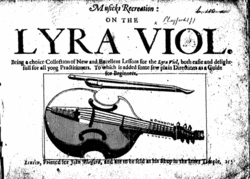Lyra viol
 |
|
| Other names | Leero viol, Leerow viol, Liera viol, Lyro viol |
|---|---|
| Classification | |
| Related instruments | |
The lyra viol is a small bass viol, used primarily in England in the seventeenth century.
Described as "the smallest of the bass viols", one should consider that the consort bass was much larger in 17th century England than most bass viols nowadays (hovering between 78 and 80 cm string length, while the division viol hovers around 76 cm (30 inches according to Christopher Simpson). The lyra viol therefore is the "smallest" and according to John Talbot (end of the 17th century) is therefore 72 cm string length. John Talbot's 17th century measurements for viols, The Orthodox viol sizes There is a large and important repertoire which was developed specifically for the lyra viol. Due to the number of strings and their rather flat layout, the lyra viol can approximate polyphonic textures, and because of its small size and large range, it is more suited to intricate and quick melodic lines than the larger types of bass viol.
The lyra viol has been favorably compared to both the lute and the violin, by Tobias Hume and Roger North respectively. The name lyra viol came into use because the playing style of bowed chords is similar to that of the lirone.
The structure of the lyra viol has been fluid throughout its history. In seventeenth century England sympathetic strings were added, which according to John Playford was credited to Mr. Farrant. This use of sympathetic may have led to the development of the baryton, but it was not a lasting development for the lyra viol. The most common lyra viols had six strings, but there were also viols with four, five or seven strings. John Playford describes the lyra viol as the smallest of three types of bass viol: the consort bass, division viol, and lyra viol. Christopher Simpson wrote that the strings on the lyra viol were lighter and the bridge flatter than those on the other bass viols. The strings were also closer to the fingerboard than they were on the consort bass. These modifications were probably in part to make playing chords easier. The first description of bowed polyphonic music for the viol is in a treatise by Johannes Tinctoris, and the first development of its repertoire can be traced back to Sylvestro di Ganassi dal Fontego in the mid-sixteenth century. This technique of chordal writing with heavy use of ornamentation became integral with the French viol composers.
...
Wikipedia
